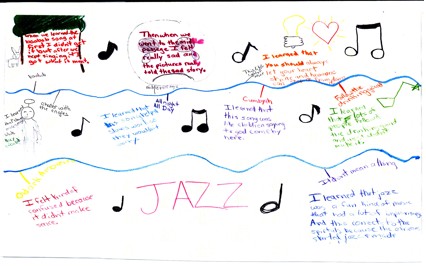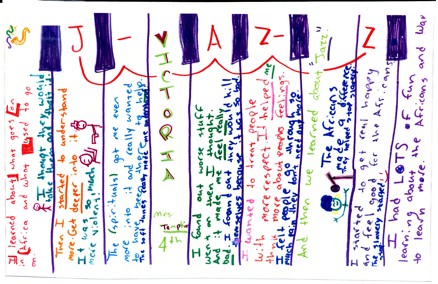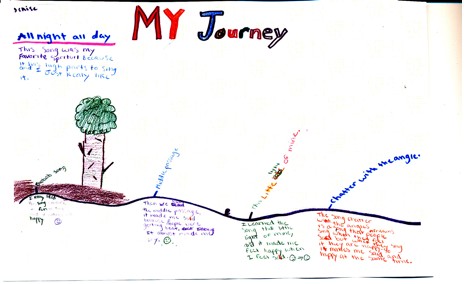Moving Across the Arts to Consider New Perspectives
by Kathryn Tompkins, Fourth Grade Teacher, Van Horne Elementary School
An exciting collaboration with our OMA (Opening Minds through the Arts) teacher opened up a compelling inquiry on slavery for my students. Jenny Cain introduced a powerful and evocative wordless picture book, The Middle Passage (Feelings, 1995), and invited students to respond with discussion, singing, music, and drama. Their connection to the book led us to read novels about slavery for literature circles in my classroom. This collaboration across our two classrooms immersed students in exploring multiple texts in the sign systems of art, music, drama, and literature and in using a range of sign systems to respond to these texts. Sign systems are “the ways in which students share and make meaning, specifically through music, art, mathematics, drama, and language” (Short, Kauffman, & Kahn, 2000, p. 160). Sign systems can thus be a way to share meaning with others through a public text, such as a song, a painting, a drama event, or a book, as well as a way to think about and make meaning in responding to these texts.
Our study began with The Middle Passage, the passionate result of twenty years of work by Tom Feelings. He researched the history of slavery and lived in Africa for two years in order to artistically portray the journey that captured Africans faced as they were taken across the Atlantic Ocean. The story is told completely through black and white illustrations, which are emotionally devastating. The first illustration shows a beautiful beach on which white men suddenly appear and attack with guns, assisted by other Africans. The Africans are killed or put in chains and taken to a boat to be loaded up as cargo. They are crammed onto the boat with no room to move. Some choose to remain peaceful, others try to revolt and are killed or beaten and chained again, while still others choose to end their suffering by jumping into the shark-infested waters. Those who live are force-fed to keep them alive until the boat pulls up to waiting crowds in the U.S., ready to purchase their new property.
The Middle Passage shocked my students into a more realistic view of the degradation of slavery and compelled them to react. As students viewed excerpts from the illustrations, the music from the movie “Amistad” was playing in the background, setting a quiet and pensive mood. Jenny, our OMA teacher, invited students to respond to the musical and visual texts using a variety of sign systems. One day they acted out scenes from the book using the drama strategy of tableau, “a still, silent performance that involves three-dimensional representations” (Wilson, 2003, p. 375). The students met in groups, discussed the scene and emotions that they wanted to portray from the book, and then practiced acting out and freezing their positions. Their facial expressions changed dramatically as they moved into the roles of the slaves and their captors.
Jenny asked students to respond to the tableau through a “tap in” strategy. She randomly tapped a particular student who was standing frozen in position and that student needed to say what he/she was thinking or feeling while staying in character. The students who were portraying the slave traders said that they were trying to keep the slaves from escaping because they were money to them. Students who portrayed the slaves said they were scared, or that they would rather die than go with their captors. One girl even said, “I want my mom,” which was powerful because the students realized that children, like themselves, were among those captured.
The strong emotions that came out through these dramas were striking in their depth of feeling and supported thoughtful discussions about the book. The students tried to put themselves in the situation of the slaves and struggled with what they would do in that situation. Many said they would fight back, no matter what the risk, to try and take over the boat. Others said that they would be too scared to do anything while some said they would jump overboard and add themselves to the trail of skeletons that led from Africa to the Americas. It was evident to us that the students were more invested in this book because they connected so deeply through using different sign systems to experience the musical and visual texts and to respond through drama and talk. The students were shocked by this honest and brutal portrayal of slavery and wanted to know more—a very different response than when they had read information about slavery in the history textbook.
I knew that we had to continue this inquiry in my classroom because students were continuing to ask many questions and felt compelled to understand more about the slave experience. I pulled together a text set of books on slavery and civil rights that included picture books, many non-fiction books including biographies, and a few chapter books. I kept these books out on the table so that students could read them whenever they had time. I was pleasantly surprised that they went straight to the books when they finished an assignment or had independent reading time.
In addition to the text set, I gathered new literature circle books for the students to read and discuss. I did a quick book talk on each chapter book and students chose one to read and discuss. Every week the students were responsible for completing an entry in their response journals to show the connections that they were making to their chosen book. They could do this through webbing their ideas, sketching to show the meanings that they were constructing, or writing their thoughts and questions. These journals provided me with an assessment of their thinking and helped them jot down their thoughts and ideas for their literature circle discussions. They met about once a week with others who were reading the same book to discuss what was going on in the book and the issues that were on their minds. The discussions especially helped some of the struggling readers to make sense of what was going on in the books.
The collection of literature circle books included Jip (Paterson, 1996), Amos Fortune Free Man (Yates, 1950), Steal Away Home (Ruby, 1994), and Escape from Slavery (Rappaport, 1991). These books all focused on issues of slavery but from different perspectives. The students were so intrigued by the books that they asked to have the chance to read a second book after we completed our first round of literature circles. We did a second round so that each was able to read and discuss a second book from this set.
I chose Jip because I felt the students would engage with Jip’s struggle to figure out his identity and would wonder how his story was related to slavery. Set in the 1850s, Jip fell off a “gypsy” wagon when he was a toddler and has been working on the town poor farm ever since. He takes care of the animals and often his friends. A “lunatic” named Put is brought to the poor farm one day and he teaches Jip, sings to him, and is a great friend—except when he has one of his crazy spells. Jip goes to school and becomes close to his teacher and a local Quaker family, all the while trying to dodge a mysterious stranger who tells Jip that he knows the identity of his father. In the end Jip has to escape when he finds out that his mother was a slave who tried to save him from his father, her master. The mystery of Jip’s family kept students engaged in the book. They were drawn to the characters and got a completely different view of slavery. Those who read Jip said that it was a book that they could not put down. They wanted to know what would happen to him and often discussed how there were people who took action during this time period, like the Quaker family and the teacher who help Jip. The students did not see Jip as a slave but as a boy trying to live his life in a difficult time. Jip did not travel across the middle passage but his life was forever changed by slavery.
Amos Fortune was a book I had heard of but not previously read. The book begins in Africa and tells about life before the slave traders came. The story begins in 1725 with the At-mun-shi tribe celebrating the harvest with their chief and his children, seventeen year old Prince At-mun and twelve year old Princess Ath-mun. Suddenly the chief slouches over, but before the tribe can recognize the prince as their new chief, the older men, women and children are taken away. The prince is forced to leave his sister behind and is taken along with most of his tribe to wait in a pit. There they are joined by many other tribes and are rarely fed until one day they are cleaned up and presented to the slave traders. All who meet approval are loaded on a ship and forced to say good-bye to their land and their lives. After two months on the ship, those who have survived the journey remember little about who they are. At-mun knows only that he is a king. He is sold to a man who is against slavery, who wants to give him a Christian home and have him help around the house. At-mun is renamed Amos and is taught how to read and write. Amos grows to care about the family, but fifteen years later his “master” dies and he is sold once again. In 1769 Amos was granted his freedom when he was almost sixty years old and spent the rest of his life working to free slaves and to help other free people. The students seemed to relate to this book because they saw the transition of a young man from African prince to captured slave to free man. They felt the story was more complete in following someone through a life time and multiple transformations.
I knew that the mystery of Steal Away Home would draw in students and I was impressed with the focus on the bravery of those involved with the Underground Railroad. The story takes two view points, beginning in the current with a young girl named Dana who is ripping down wall paper in her new house. Behind the paper she finds a hidden room with a skeleton and a diary. Dana spends the rest of the book trying to identify the remains and figure out their story. Her chapters alternate with the chapters that focus on James, a young boy who lived in Dana’s house in the 1850s, and whose mother’s diary gives insight into the life behind the skeleton. James is Quaker and his mother helped slaves on an Underground Railroad stop. The skeleton was a brave young African American woman named Lizbet Charles who worked to free slaves before she became ill and died. Her skeleton was sealed up in the house to protect James’ family from legal action for helping escaped slaves. The students who read this book were relieved that there were families who were willing to risk their own safety. This book gave them a sense of hope and helped them think more realistically about ways of taking action.
Escape from Slavery, Five Journeys to Freedom was the last book we read and is based on actual accounts of slaves who risked their lives to try for freedom. I knew that the students would relate to the book because of their interest in the experiences of slaves and the risks they were willing to take. The stories seemed to define bravery for students. I also liked how the book was divided into short stories so that students learned about the many different escape plans that slaves created. The story that the students talked the most about was of the husband and wife who pretended to be slave and slave owner and were able to escape. The wife was very light skinned so she could pass as an old white man. The class was impressed at the brilliance of this plan and the huge risk they took by escaping in full view of slave traders.
After the class read through the text set and two of the literature circle books, they drew visual images about their thinking on slavery and civil rights and wrote reflections about their sketches. I wanted to give students an opportunity to pull together their thoughts on the books that they read and explore what the books meant to them. I discovered that they felt a sense of hope because of people like the Quakers. I hadn’t realized how much the role of Quakers was highlighted in the literature circle books but students clearly felt that they played a huge role in aiding slaves on the Underground Railroad. They were angry with anyone who was involved in owning a slave and some drew chains to symbolize slavery. The students had a new respect for slaves and people helping slaves who demonstrated courage during such horrible times. From The Middle Passage to their literature circle books, they appreciated those willing to risk their lives in order to challenge slavery as wrong. Slavery had changed from “a thing that happened a long time ago” to an event in American history that was real and shocking for the students.
While we were reading novels and picture books in our classroom, we continued learning about slavery and civil rights in OMA. Jenny took us on a journey through time, beginning with slavery and moving into the spirituals and music that were a part of that time, and then tracking how this music later led to the creation of jazz by African Americans. The students had the opportunity to learn to sing the songs and to play them on instruments. They studied famous jazz musicians and their contributions to the jazz era. This focus allowed students to celebrate the contributions and talents of African Americans, rather than only viewing their history and struggles with sympathy.
At the end of our study, students completed final responses in OMA to show their learning and thinking on graffiti boards. Graffiti boards (Short & Harste, 1996) usually involve a group of students who respond through sketches, quotes, and connections in an unorganized way on a large sheet of paper. We chose to do a variation of graffiti boards where each student was responsible for making his or her own graffiti board. As students began to think through their responses it was interesting to watch their struggle with what to represent on their boards because they had been so moved and infuriated by the conditions of slavery but were inspired by the spirituals and the music created by the African-American community.
The students learned from many different sign systems (drama, singing, art, and writing) throughout this experience in ways that seemed to deepen and extend their learning. They read about slavery, but were also immersed in visual and musical texts that provided for more complexity in their understandings of African American experiences and history. Using tableau to reenact scenes from The Middle Passage affected them on a much deeper level because they had to put themselves in the situation, whether they portrayed the slave or the slave trader. Encouraging students to respond through art as well as language allowed them to use their strengths in different sign systems as ways of thinking about ideas that were significant to them. They thought about the books using movement, music, and art and so engaged more intensely with the issues of slavery and civil rights from a wider range of perspectives. We engaged with the arts, not as cute activities, but as multiple ways of knowing and thinking about the world.
References
WOW Stories, Volume I, Issue 2 by Worlds of Words is licensed under a Creative Commons Attribution-NonCommercial-ShareAlike 4.0 International License.
Based on a work at https://wowlit.org/on-line-publications/stories/storiesi2/.







One thought on “WOW Stories: Connections from the Classroom”